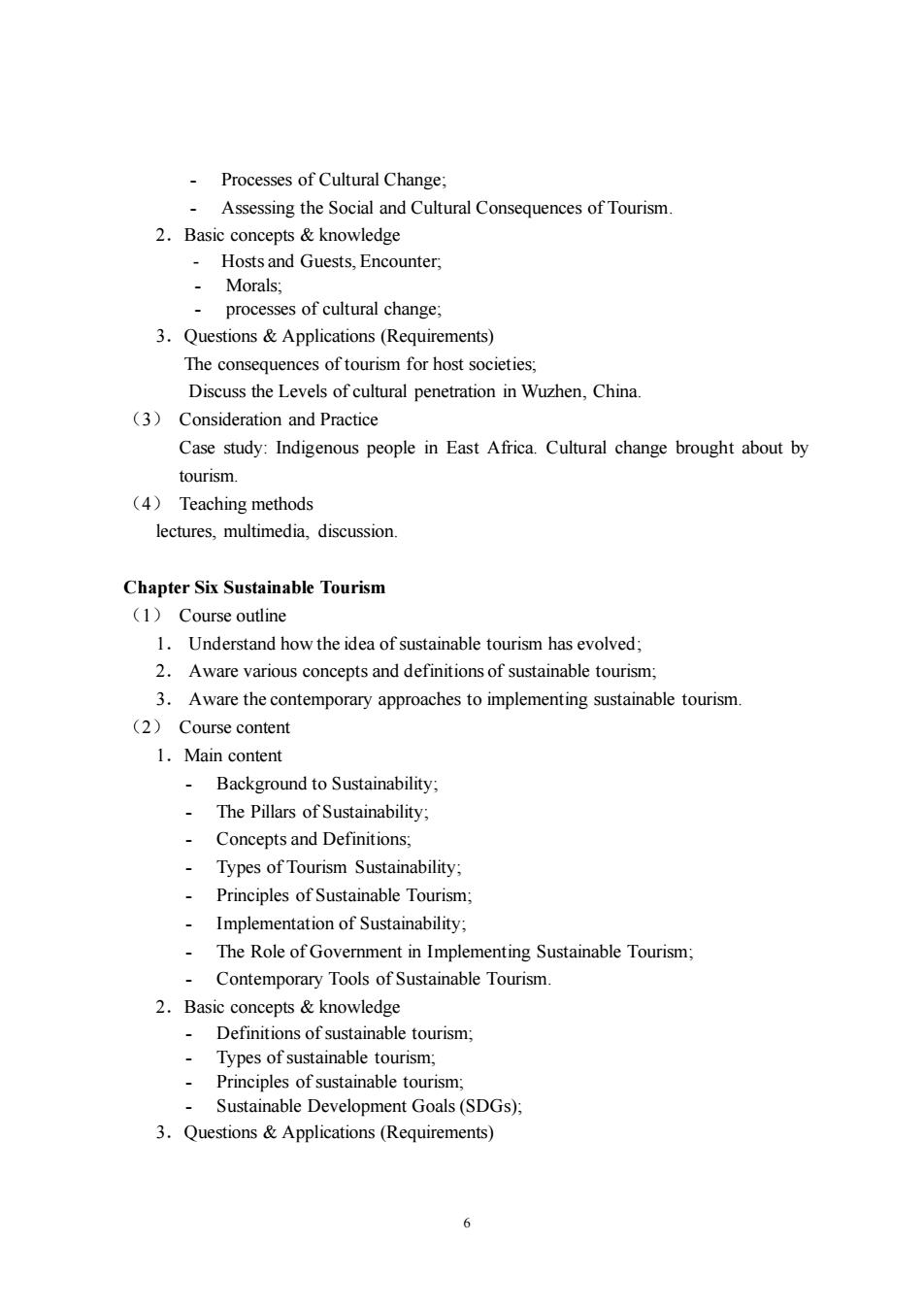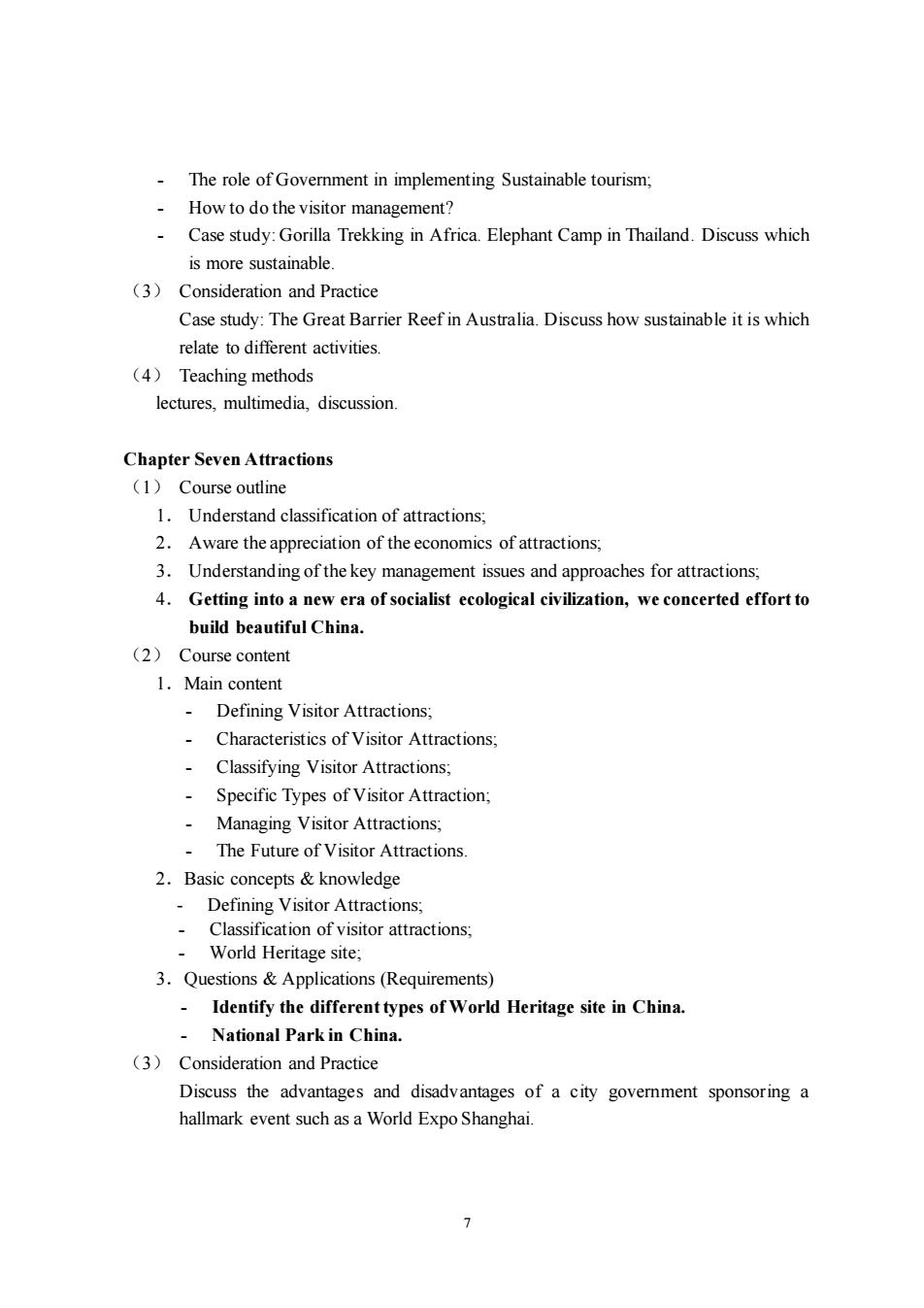
-Processes of Cultural Change; Assessing the Social and Cultural Consequences of Tourism 2.Basic concepts knowledge -Hosts and Guests,Encounter. Morals processes of cultural change; 3.Questions Applications(Requirements) The consequences of tourism for host societies; Discuss the Levels of cultural penetration in Wuzhen,China. (3)Consideration and Practice Case study:Indigenous people in East Africa.Cultural change brought about by tourism. (4)Teaching methods lectures,multimedia.discussion Chapter Six Sustainable Tourism (1)Course outline 1.Understand how the idea of sustainable tourism has evolved: 2.Aware various concepts and definitions of sustainable tourism 3.Aware the contemporary approaches to implementing sustainable tourism. (2)Course content 1.Main content Background to Sustainability; The Pillars of Sustainability: Concepts and Definitions 、 Types of Tourism Sustainability Principles of Sustainable Tourism: -Implementation of Sustainability The Role of Government in Implementing Sustainable Tourism; Contemporary Tools of Sustainable Tourism. 2.Basic concepts&knowledge -Definitions of sustainable tourism; Types of sustainable tourism; eiples of sustainable Sustainable Development Goals(SDGs) 3.Questions Applications(Requirements) 6
6 - Processes of Cultural Change; - Assessing the Social and Cultural Consequences of Tourism. 2.Basic concepts & knowledge - Hosts and Guests, Encounter; - Morals; - processes of cultural change; 3.Questions & Applications (Requirements) The consequences of tourism for host societies; Discuss the Levels of cultural penetration in Wuzhen, China. (3) Consideration and Practice Case study: Indigenous people in East Africa. Cultural change brought about by tourism. (4) Teaching methods lectures, multimedia, discussion. Chapter Six Sustainable Tourism (1) Course outline 1. Understand how the idea of sustainable tourism has evolved; 2. Aware various concepts and definitions of sustainable tourism; 3. Aware the contemporary approaches to implementing sustainable tourism. (2) Course content 1.Main content - Background to Sustainability; - The Pillars of Sustainability; - Concepts and Definitions; - Types of Tourism Sustainability; - Principles of Sustainable Tourism; - Implementation of Sustainability; - The Role of Government in Implementing Sustainable Tourism; - Contemporary Tools of Sustainable Tourism. 2.Basic concepts & knowledge - Definitions of sustainable tourism; - Types of sustainable tourism; - Principles of sustainable tourism; - Sustainable Development Goals (SDGs); 3.Questions & Applications (Requirements)

-The role of Government in implementing Sustainable tourism; How to do the visitor management? Case study:Gorilla Trekking in Africa.Elephant Camp in Thailand.Discuss which is more sustainable. (3)Consideration and Practice Case study:The Great Barrier Reef in Australia.Discuss how sustainable it is which relate to different activities (4)Teaching methods lectures multimedia discussion Chapter Seven Attractions (1)Course outline 1.Understand classification of attractions, 2.Aware the appreciation of the economics of attractions; 3.Understanding ofthe key management issues and approaches for attractions 4.Getting into a new era of socialist ecological civilization,we concerted effort to build beautiful China. (2)Course content 1.Main content -Defining Visitor Attractions; Characteristics of Visitor Attractions: 、 Classifying Visitor Attractions. Specific Types of Visitor Attraction 、 Managing Visitor Attractions; The Future of Visitor Attractions 2.Basic concepts knowledge Defining Visitor Attractions Classification of visitor attractions. World Heritage site: 3.Questions&Applications(Requirements) Identify the different types of World Heritage site in China. National Park in China (3)Consideration and Practice Discuss the advantages and disadvantages of a city govemment sponsoring a hallmark event such as a World Expo Shanghai
7 - The role of Government in implementing Sustainable tourism; - How to do the visitor management? - Case study: Gorilla Trekking in Africa. Elephant Camp in Thailand. Discuss which is more sustainable. (3) Consideration and Practice Case study: The Great Barrier Reef in Australia. Discuss how sustainable it is which relate to different activities. (4) Teaching methods lectures, multimedia, discussion. Chapter Seven Attractions (1) Course outline 1. Understand classification of attractions; 2. Aware the appreciation of the economics of attractions; 3. Understanding of the key management issues and approaches for attractions; 4. Getting into a new era of socialist ecological civilization, we concerted effort to build beautiful China. (2) Course content 1.Main content - Defining Visitor Attractions; - Characteristics of Visitor Attractions; - Classifying Visitor Attractions; - Specific Types of Visitor Attraction; - Managing Visitor Attractions; - The Future of Visitor Attractions. 2.Basic concepts & knowledge - Defining Visitor Attractions; - Classification of visitor attractions; - World Heritage site; 3.Questions & Applications (Requirements) - Identify the different types of World Heritage site in China. - National Park in China. (3) Consideration and Practice Discuss the advantages and disadvantages of a city government sponsoring a hallmark event such as a World Expo Shanghai